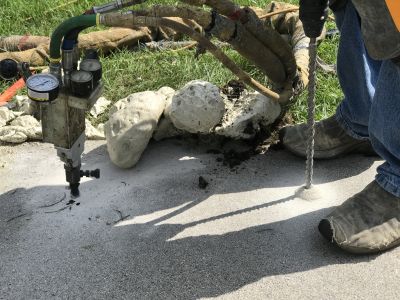Expert Picks for Essential Concrete Leveling Equipment and Supplies
Find out which products industry experts recommend for achieving smooth, level concrete surfaces with minimal effort.
 Concrete leveling is an essential process for maintaining the safety and appearance of various surfaces around residential and commercial properties. Over time, concrete slabs can settle, crack, or become uneven due to soil movement, moisture changes, or general wear and tear. Selecting the right products for concrete leveling can help restore the surface's integrity without the need for complete removal and replacement. These products are designed to fill voids, raise sunken slabs, and provide a stable foundation for walkways, driveways, patios, and other flat surfaces.
Concrete leveling is an essential process for maintaining the safety and appearance of various surfaces around residential and commercial properties. Over time, concrete slabs can settle, crack, or become uneven due to soil movement, moisture changes, or general wear and tear. Selecting the right products for concrete leveling can help restore the surface's integrity without the need for complete removal and replacement. These products are designed to fill voids, raise sunken slabs, and provide a stable foundation for walkways, driveways, patios, and other flat surfaces.
Top Overall Option
Polyurethane Foam Injection System
A versatile and minimally invasive solution, polyurethane foam injection systems are widely used for leveling and stabilizing sunken concrete slabs. They work by injecting expanding foam beneath the surface, filling voids and lifting the slab to a more even position. These systems are appreciated for their quick curing times, low odor, and ability to access hard-to-reach areas. Suitable for both small repairs and larger projects, polyurethane foam offers a clean and efficient approach to concrete leveling.
Types of Products For Concrete Levelings
Polyurethane Foam Kits
Pre-packaged kits containing foam and applicators for DIY or professional use, suitable for small to medium repairs.
Hydraulic Jack Lifting Devices
Tools used to manually lift and level slabs, often combined with other materials for stabilization.
Self-Leveling Compounds
Pourable products that can fill small cracks and create a smooth, level surface for flooring or finishing.
Polymer Modified Mortars
Flexible repair mortars designed to fill cracks and small voids while accommodating slight movements.
Epoxy Injection Systems
Used primarily for crack repair and structural stabilization, injecting epoxy resin into damaged areas.
Concrete Patching Materials
Ready-mix patches for surface repairs, filling holes and minor surface imperfections.
Grouting Products
Flowable grout materials for filling larger voids beneath slabs and providing support.
Vibratory Compactors
Tools used to compact soil beneath slabs prior to leveling to improve stability.
Anchor Bolts and Fasteners
Hardware used to secure slabs after leveling or to attach slabs to underlying structures.
Surface Sealers
Protective coatings that seal repaired surfaces against moisture and further damage.
Underpinning Materials
Specialized products used to stabilize and lift foundations and large slabs.
Popular Choices
Widely used for their ease of application and quick results, these kits are favored for residential repairs.
Commonly employed for manual slab adjustments, offering control over the lifting process.
Ideal for creating smooth surfaces over uneven slabs, often used in flooring projects.
Popular for sealing cracks and restoring structural integrity in concrete slabs.
Favored for quick surface repairs and minor patching needs.
Effective for filling large voids and stabilizing slabs from beneath.
Used to prepare the ground before leveling, ensuring a stable base.
Portable tools for compacting soil and gravel under slabs, enhancing stability.
Applied to protect and extend the life of repaired concrete surfaces.
Used in foundation stabilization projects, especially for large-scale repairs.
Modern concrete leveling products include a range of materials and tools that cater to different types of repairs and project scales. From polyurethane foam injections to hydraulic jacks and self-leveling compounds, there are options suitable for DIY enthusiasts and professional contractors alike. Understanding the specific needs of your project, such as the size of the area, the extent of the damage, and the underlying soil conditions, can guide you toward the most appropriate product choices.
When considering concrete leveling solutions, it is important to evaluate the ease of application, curing time, durability, and compatibility with existing surfaces. Proper preparation, including cleaning the area and assessing the extent of the damage, can significantly influence the success of the repair. Many products now feature quick-setting formulas and minimal odor, making them convenient and safer to use in various environments.
Investing in quality leveling products can help prolong the lifespan of your concrete surfaces, improve safety by reducing trip hazards, and enhance the overall appearance of your property. Whether undertaking a small repair or a large-scale project, selecting the right materials and tools is crucial for achieving reliable and long-lasting results.
Key Buying Considerations
- Identify the extent of the unevenness or damage to determine the appropriate product type.
- Consider the size of the area needing repair to select suitable product quantities and tools.
- Evaluate the ease of application, especially if opting for DIY solutions.
- Check curing or drying times to plan project timelines accordingly.
- Assess the compatibility of the product with existing concrete surfaces and underlying soil conditions.
- Look for products with clear instructions and safety guidelines.
- Determine if additional tools or accessories are needed for application, such as pumps, mixers, or protective gear.
- Consider the environmental conditions during application, such as temperature and humidity.
- Review the durability and long-term stability provided by the product, especially for high-traffic areas.
- Estimate the overall project budget, including materials, tools, and potential professional assistance.
- Check for any specific local regulations or building codes related to concrete repairs.
- Research product reviews and ratings to gauge user experiences and effectiveness.
- Ensure the product is suitable for the specific type of concrete and repair scenario.
- Consider whether the product offers flexibility for future repairs or adjustments.
